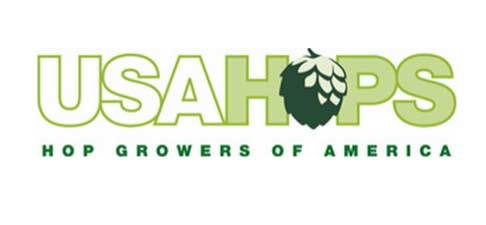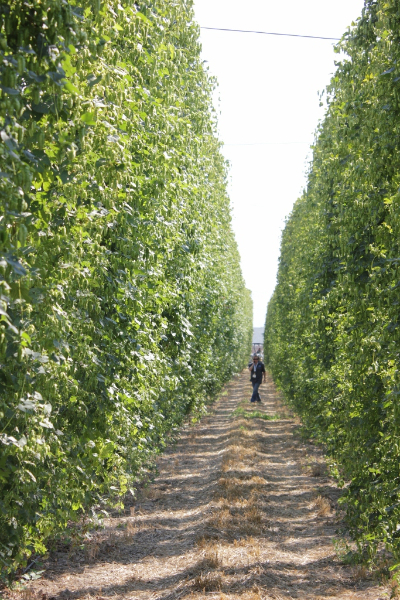Local and not-so-local news sources have been reporting what they assume will be bad news. One article I saw was titled IPA Lovers Beware: Beer Prices Could Skyrocket. Another warned Trouble Brewing: Drought-Hit Hops Crop Concerns Craft Brewers. One local television news outlet went completely hysterical, warning that Washington drought may threaten future of craft brewers.
Without histrionics, here’s a look at drought’s impact on the annual hop crop and the price of your pint. No surprise, the situation is probably not as dire as many media outlets would have you believe.
 According to Hop Growers of America (HGA)*, the drought was not a surprise to hop farmers who periodically deal with water shortages. Also, the dry conditions will only impact a portion of the Northwest’s hop production. According to HGA an increase in total acreage should counteract the impact of the weather.
According to Hop Growers of America (HGA)*, the drought was not a surprise to hop farmers who periodically deal with water shortages. Also, the dry conditions will only impact a portion of the Northwest’s hop production. According to HGA an increase in total acreage should counteract the impact of the weather.
In short, the rumors of the hop crop’s demise are widely exaggerated. There will likely be an impact, but not devastation. It’s a nuanced story that invites deeper consideration.
Crisis? What Crisis?
According to reports released this week at the International Hop Growers’ Congress in Germany, the 2015 U.S. hop crop is expected to exceed last year’s 71 million pound crop. The current estimate for the 2015 U.S. crop is 74.5 million pounds. This total represents over 50 different hop varieties, and each individual variety will be impacted at varying levels. (for more info see our previous post about the annual hop acreage report.)
[singlepic id=815 w=400 h= float=right]That’s not to say the weather will have no impact on the hop harvest. Some aroma varieties are expected to be more greatly impacted by last month’s hot weather, with possible reductions of 10 to 15 percent below average. However, some varieties are thriving in the heat. The impact is mixed. For 2015 the total hop acreage was increased by 15 percent and that is expected to moderate the effects of the drought.
For hop farmers, the possibility of drought is not new. Most hop farms are generations old and they’ve seen this kind of situation before.
Some hop growers and irrigation districts have recently invested in new technologies to ensure efficient use of the available water, installing more-efficient drip irrigation systems on all hop acreage. In some cases they’ve piped and lined ditches and canals to reduce evaporation and seepage. Some hop farmers are in the process of such upgrades while others are opting not to upgrade.
If You Must Worry
The news is not so good for hop growers in Europe, where they have also experienced above-average temperatures and low rainfall. Most European hop acreage is not irrigated and rainfall is needed in the next two weeks to prevent losses. Current estimates from several European hop producing countries are 10 to 20 percent lower than last year’s excellent crop.
European breweries will need hops and U.S. growers will have them, which could impact your local brewery’s ability to get the tasty hops it needs for your favorite IPA. Luckily, Europeans typically do not favor the aroma varieties that our northwestern palates crave.
[singlepic id=708 w=400 h= float=right]Overall the news is still pretty good according to Hop Growers of America. The current projection for the 2015 world hop crop is 198.2 million pounds, down from 211 million pounds in 2014, but higher than the 2013 crop of 180 million pounds. The projected 5 percent increase in this year’s U.S. crop partially offsets the reduction from other hop producing countries.
“With over 6,000 newly expanded acres of popular and expanding hop varieties in the U.S. in 2015, along with additional first-year plantings that have replaced other varieties, there is a large proportion of “baby” hops that in the best of growing conditions will have smaller first-year yields,” says Ann George, Executive Director of Hop Growers of America. “These new plantings are a direct result of demand and forward contracting by breweries, an important and crucial tool for breweries to communicate their needs and ensure supply. Forward contracting prevents shortages and allows growers to better meet the demands of the industry.”
Your Pint Price
Regarding the impact on the price of your favorite IPA, that remains to be seen. According to the Hop Growers of America, there may be some increase in the prices for certain popular hop varieties in the “spot” (uncontracted) market. But most of the additional costs from lower hop yields will be absorbed by the growers, who have locked in prices with breweries that have signed multi-year contracts. If the brewer’s prices don’t increase, we can only hope that the consumer’s prices won’t increase.
Likely, your favorite brewery has a contract-protected price on it supply of the hops it needs to produce your favorite IPA. Presumably the hop suppliers will honor those contracted prices and we will all survive the drought. Perhaps this year will serve as a lesson on the virtues of hop contracts and the perils of the spot market.
To be fair, some brewers tell horror stories of hop suppliers not honoring contracts, by either jacking up prices or failing to deliver the contracted quantities of hops. If such stories are true, that’s actually a legal matter and really doesn’t have anything to do with the drought.
Whatever the case, fingers crossed for more rain next year.
* Hop Growers of America is just one organization, but they certainly are well-informed. Based out of Moxee, Washington, in the heart of hop-growing country, HGA facilitates conversations between growers, merchants, and brewers, providing statistical reports to the industry and education on the quality, variety, and tradition of American-grown hops.


































One positive impact we can look forward to, this is a chance for hop breeders to select for cultivars that are more drought resistant! My “the nonic is half full” outlook.